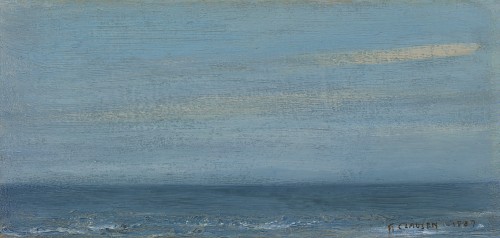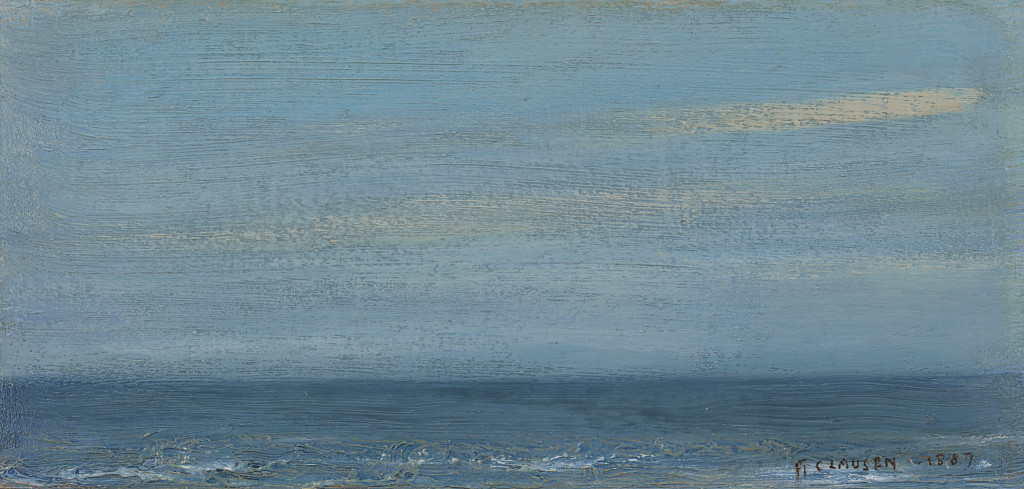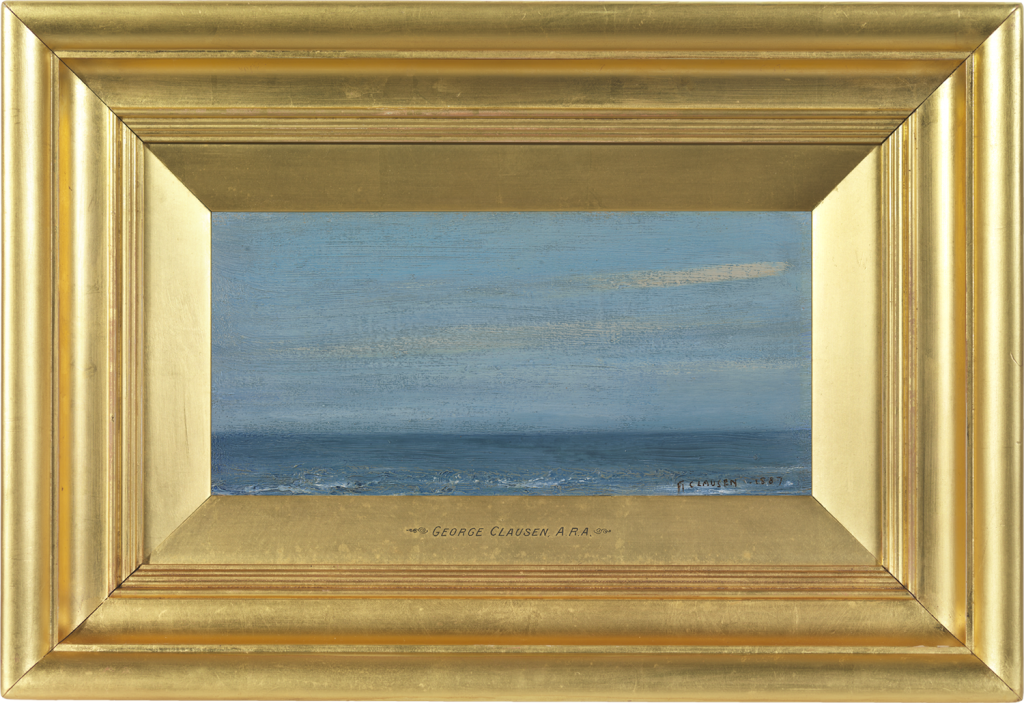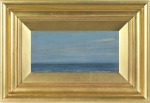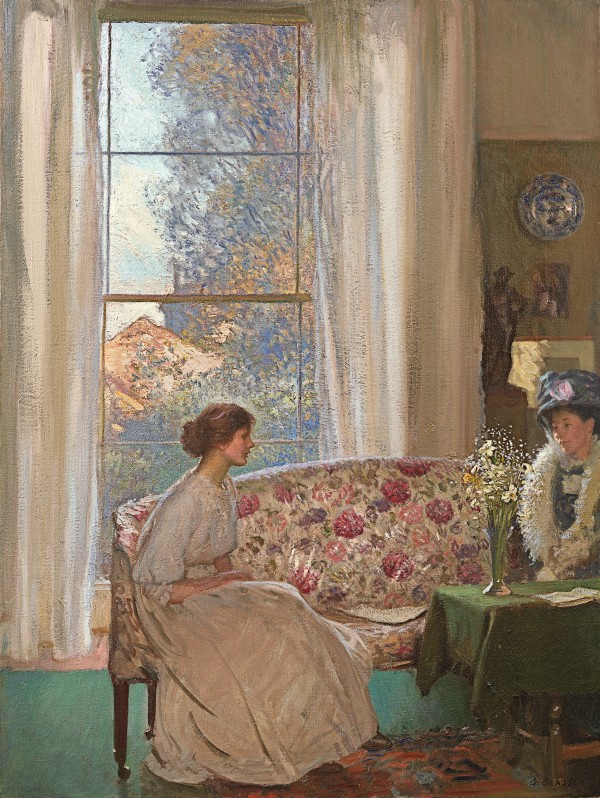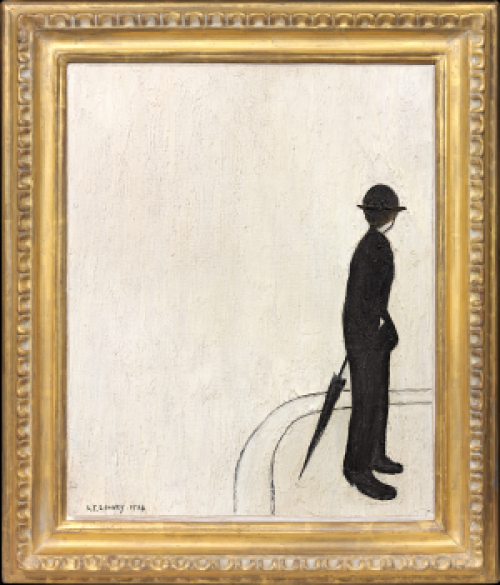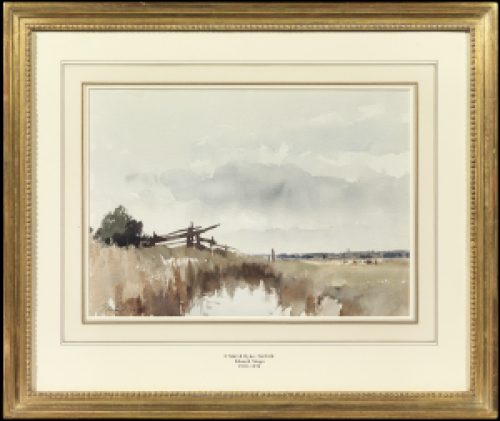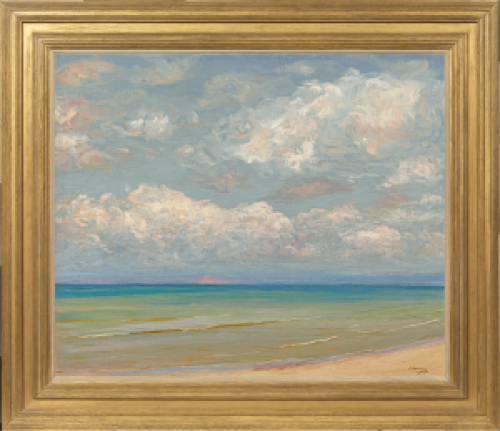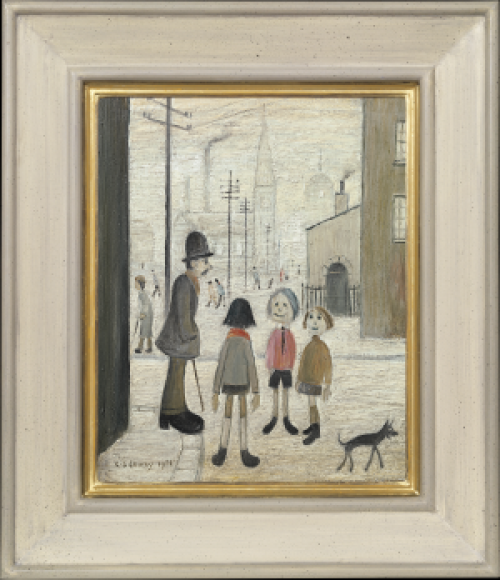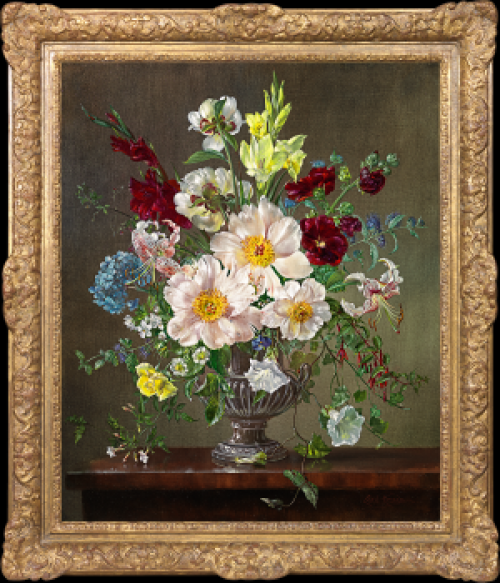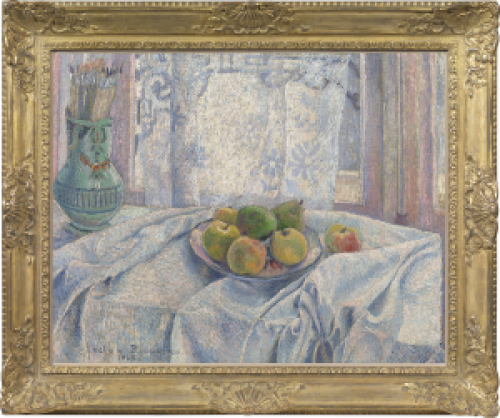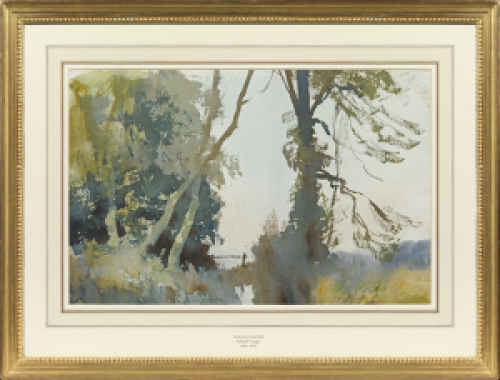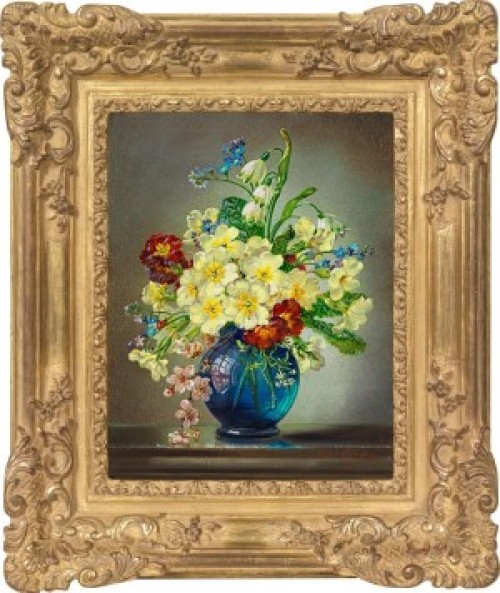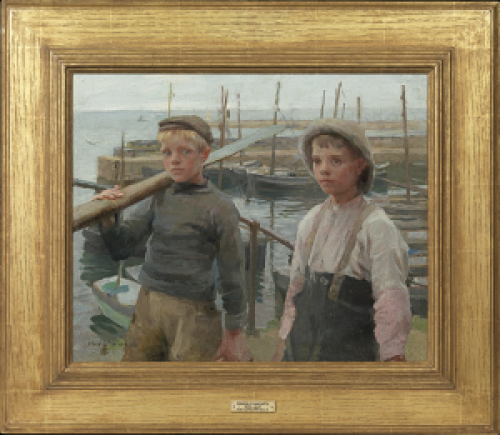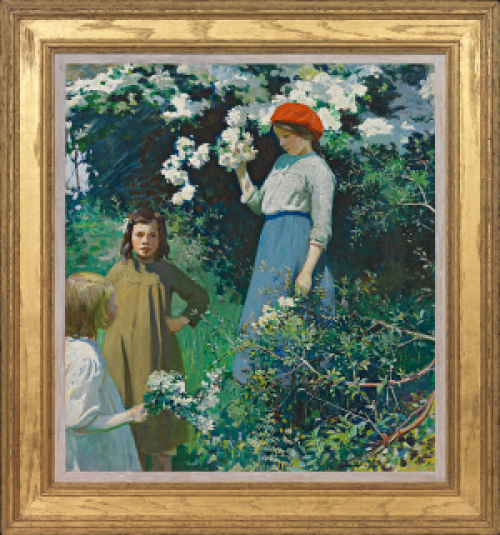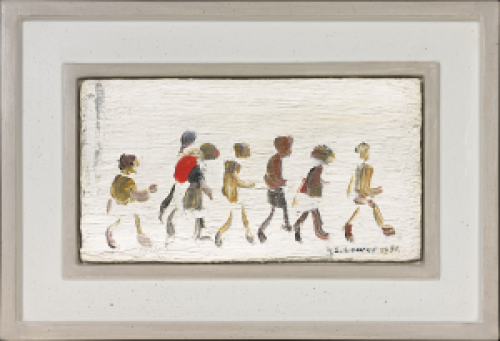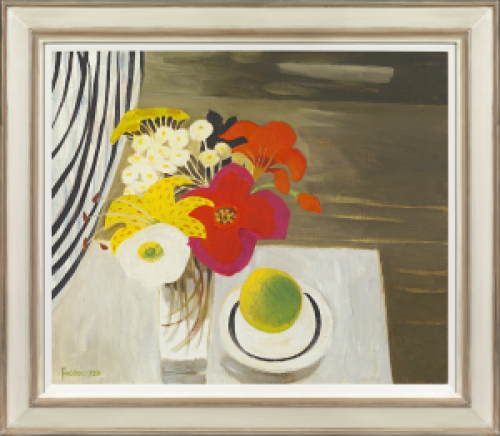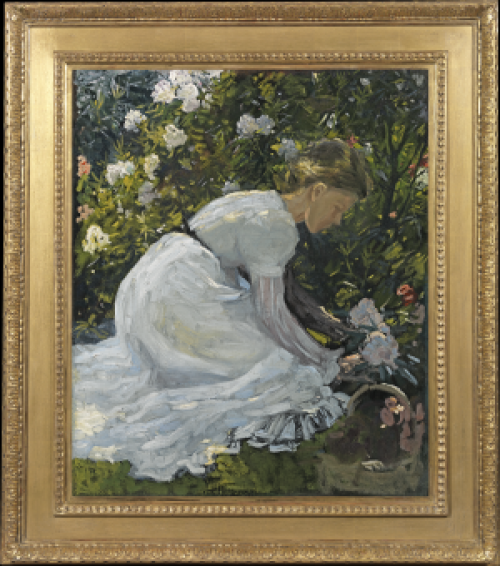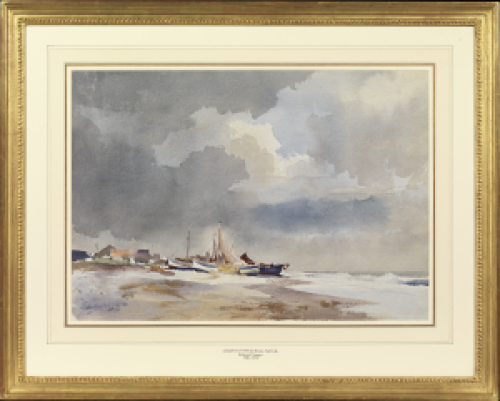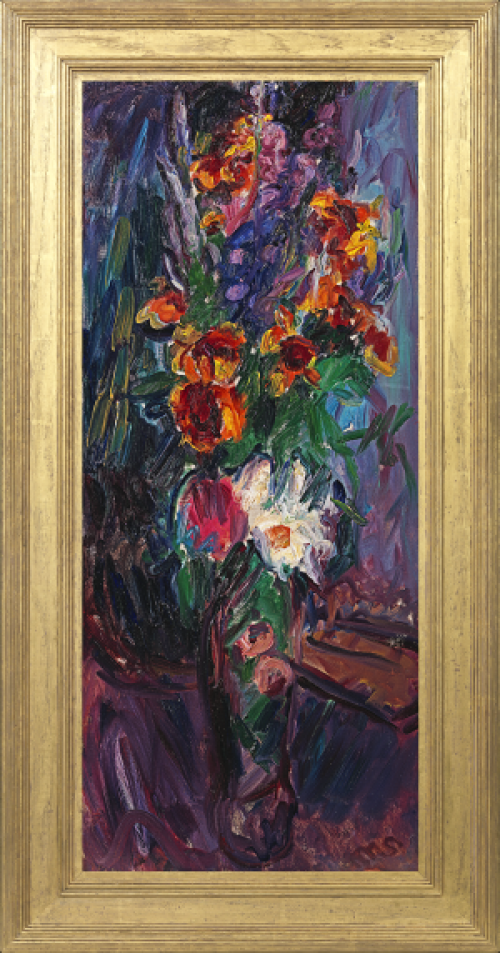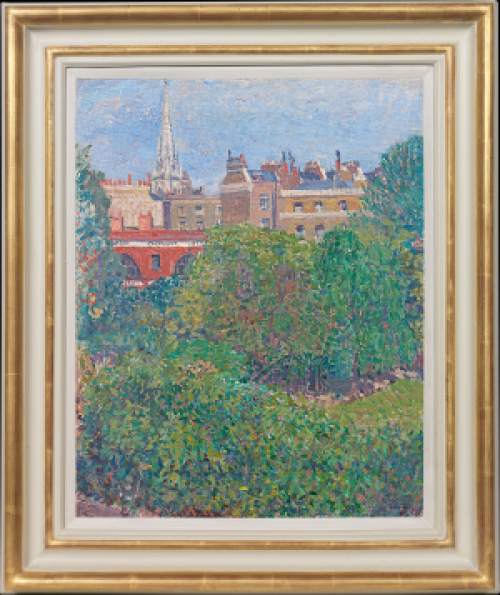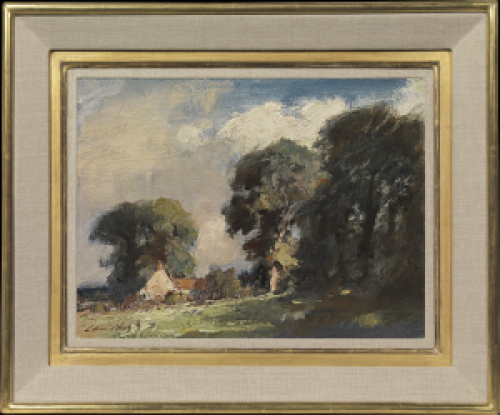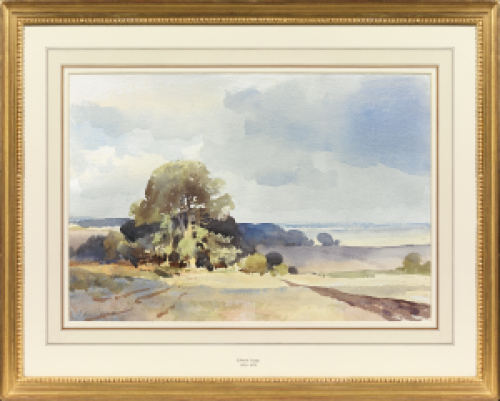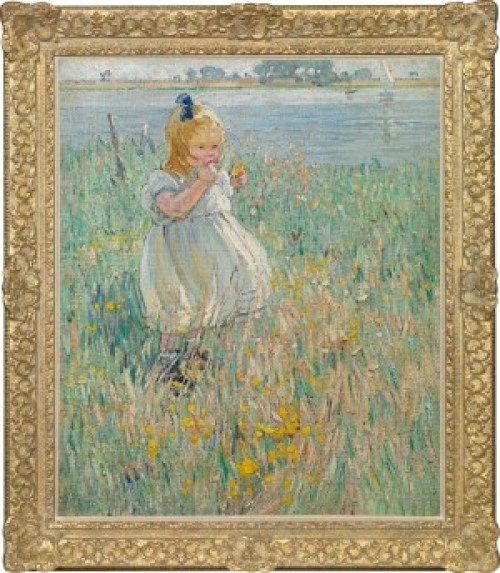SIR GEORGE CLAUSEN RA RWS
London 1852 - 1944 Cold Ash, Newbury
Ref: BK 255
Sea deep blue
Signed and dated lower right: G CLAUSEN 1887
Oil on panel: 4 ⅜ x 9 ¼ in / 11.1 x 23.5 cm
Frame size: 10 ¼ x 15 in / 26 x 38.1 cm
In its original gilded composition frame
Provenance:
Private collection, UK
In the late summer of 1887 the Clausen family went on holiday to Saltfleetby on the north Lincolnshire coast.[1] The area was favoured partly because Agnes, the painter’s wife, hailed from Kings Lynn and her brother, Alfred Webster, held a teaching post at Lincoln School of Art. From the one surviving small oil on panel study (fig 1), we can deduce that the weather was grey and overcast, although as the painter noted in a letter that, ‘the country here is very good – broad, flat, melancholy or rather solemn’.[2]
Fig 1 George Clausen, Saltfleetby, 1887, 15 x 23.9 cm, Private Collection
It is likely that Clausen returned to his home at Cookham Dean in Berkshire, before setting off again for an extended autumn painting expedition to the artists’ colony at Étaples in northern France. There he probably met the ailing Irish painter, Frank O’Meara, along with a group of American followers of Jules Bastien-Lepage, while he worked in the fields around the nearby village of Dannes.[3] Extant small oil studies indicate that the weather in France was favourable, and the potato harvest, the subject of his New English Art Club exhibit of 1888, was in full swing.[4] He also painted the exceptionally fine Normandy Peasant (fig 2) at this time.
Fig 2 George Clausen, A Normandy Peasant, 1887, 52.5 x 28.5 cm, The Potteries Museum, Stoke-on-Trent
The range of his smaller on-the-spot oil studies can however, only be surmised from sundry notes in his account book. Thus, on 3 December 1887, he listed five ‘pochades’ at £10 and £5, the two smallest of which were seascapes, described as ‘Sea (light blue)’ and ‘Sea Deep Blue’. While we must assume that these were painted either at Saltfleetby or Étaples it is likely that the present picture is the second of these. Its depth of blue suggests that it is more likely to have been observed on the French coast, looking west, than on the English coast, looking east (fig 3). [5]
These two small seascapes are almost unique in the Clausen oeuvre and no other oil paintings of the sea have been traced after 1887.[6] During his years as a young artist in the mid-1870s, the painter produced seascapes at Volendam, on the Zuider Zee, which are characteristically tonal (fig 4). The present picture responds to these early sketches with a ‘colour note’ that is shrill and positive. For all its deceptive simplicity, great subtlety is concentrated into this vivid perception of the sea. Artists on such occasions face the challenge of painting a continuous plane that recedes to the horizon. There are no convenient perspectives; no fields, trees or hills to help articulate the space – only the subtlest modulation of colour on the surface of the ocean. For these reasons, the sea was an endless source of fascination and looking into its far distances was touching what French painters such as Gustave Courbet habitually referred to as l’immensité.
Fig 3 George Clausen, Seascape, Deep Blue, 1887, 11.4 x 23.9 cm, the present picture
Fig 4 George Clausen, Sketch of Sailing Boats on the Sea, c. 1875-6, 20.6 x 35.4 cm, Royal Academy of Arts, London
It is likely that when painting this tiny panel, Clausen was led back to thoughts of James McNeill Whistler. As a student he had first encountered the American artist, accompanied by his assistants, the Greaves brothers, at a private life class in Chelsea run by a French costumier named Barthe.[7] He would have read with interest the press reports of the Whistler/Ruskin trial in 1878 and although their paths diverged he was keen to show at the Royal Society of British Artists under Whistler’s ill-fated presidency in 1886.[8] Despite the controversy surrounding the ‘master’, it seems more than likely that Clausen would have admired the tiny Whistler ‘pochades’ which he could have seen at Dowdeswell’s gallery in 1884 in a show entitled ‘Notes’ – ‘Harmonies’ – ‘Nocturnes’ (fig 5).[9] He may even have been aware of the work of the American’s current crop of pupils, principally Walter Sickert and Mortimer Menpes, who had accompanied their teacher to St Ives to paint seascapes in the early months of 1884 (fig 6). These proto-impressionists often referred to their small panel paintings as ‘colour notes’ – an appropriate description for the present work.
Fig 5 James McNeill Whistler, Cliffs and Breakers, 1884, 12.4 x 21.6 cm, Hunterian Art Gallery, University of Glasgow
Fig 6 Walter Sickert, Clodgy Point, 1884, 12.3 x 21.5 cm, Hunterian Art Gallery, University of Glasgow
By the autumn of 1888, Clausen had seen Sickert emerge as a strident force in the New English Art Club, and while he maintained his strong allegiance to Bastien-Lepage’s Naturalism, at Saltfleetby and Étaples, in front of the sea, he had cause to ponder.[10] So much of the contemporary debate about painting circled around the empirical and scientific analysis of colour. Naturalism, with the emergence of the ‘combination’ printing of Peter Henry Emerson, was being overtaken by photography – a medium that had yet to tackle colour.[11] In the air also were reports from Paris carrying news of the latest developments in Impressionism. It was a challenging time. Yet staring at the sea was in itself a liberation. Yes, the naturalistic obligation of ‘truth to appearances’ remained, but in this moment of serenity, all the hubbub of aesthetic debate was subsumed under a shimmering veil of ultramarine.
Kenneth McConkey
SIR GEORGE CLAUSEN, RA, RWS
London 1852 - 1944 Cold Ash, Newbury
The son of a painter of Danish descent, Sir George Clausen was born in London. He studied at the South Kensington School of Art from 1873 - 75 and then visited Belgium and Holland between 1875-76. Influenced initially by Dutch painting and Whistler during the 1870s, he transferred his allegiance to Jules Bastien-Lepage and the French plein-air school of painting in the early 1880s. Closely identifying with English rural life, he favoured naturalism during this period as a technique of what he called 'studied impartiality' with its emphasis on literal representation rather than narrative content. For a few months in 1883, he studied at the Academie Julian under Adolphe William Bouguereau.
During the 1890s, Clausen became increasingly aware of the limitation of rustic naturalism. Influenced by the French Impressionists, he developed a more fluent style, showing a renewed interest in figural expression and movement, and a preoccupation with the play of sunlight and shade.
Following his marriage in 1881, he settled first in Berkshire and then in Essex where the surrounding scenery inspired much of his work. From 1876-1943, he exhibited regularly at the royal Academy; he was a founder member of the New English Art Club in 1886 although he ceased to exhibit there following his election as an Associate of the Royal Academy in 1895 and a Royal Academician in 1908.
[1] Kenneth McConkey, George Clausen and the picture of English Rural Life, 2012 (Atelier Books, Edinburgh), pp.81-2.
[2] Letter to James Stanley Little, dated 7 August 1887; quoted in McConkey, 2012, p.81.
[3] O’Meara, suffering from malaria, had left Grez-sur-Loing in July and returned to Carlow in Ireland for treatment. He set off for Étaples in mid-November. I am grateful to Mary Stratton Ryan for confirming O’Meara’s movements during the autumn of 1887. For the Americans at Étaples, see Jean-Claude Lesage, Peintres Américains en Pas-de-Calais, La Colonie d’Étaples, 2007 (AMME Éditions, Abbeville, France). Clausen may have been accompanied by Webster for at least part of his stay.
[4] See McConkey 2012, p.86.
[5] The picture went to Goupil & Co, the artist’s dealer, but no note is made of its eventual sale. It was entered in the Goupil stock books on 31 December 1887, as ‘Study of Sea’, priced at 62.5 francs, and at that point indicated as ‘non-vendu’. Almost imperceptible indications of coastline on the horizon tend to confirm that this may be a view across the English Channel from northern France.
[6] ‘Sea (light blue)’ has not been traced, During the 1930s the painter produced a number of watercolour coastal views on holidays on the Suffolk coast.
[7] McConkey, 2012, p.22.
[8] See for instance, Ronald Anderson and Anne Koval, James McNeill Whistler: Beyond the Myth, 1994 (John Murray), pp. 272-282. Clausen for instance showed A Girl’s Head, 1886 (Manchester City Art Gallery) at the British Artists in the winter of 1886 where The Magazine of Art acclaimed it as ‘the best picture in the exhibition’; see McConkey 2012, pp.78-9.
[9] See Kenneth John Myers, Mr Whistler’s Gallery, Pictures at an 1884 Exhibition, 2003 (Freer Gallery of Art, Smithsonian Institution, Washington DC).
[10] Kenneth McConkey, The New English, A History of the New English Art Club, 2006 (RA Publications), pp.47-54.
[11] See Veronica Sekules and Neil MacWilliam eds., Life and Landscape: Peter Henry Emerson, Art and Photography in East Anglia, 1880-1900, 1986 (exhibition catalogue, Sainsbury Centre for the Visual Arts, Norwich). Clausen had already sold a head study to Emerson by this stage and was in contact with him regarding his theories of ‘naturalistic photography’; see McConkey 2012, pp.79-80, 94-5.

